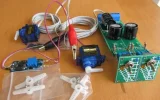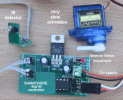I am getting all nerdy and am going to use a python program running on a raspberry pi to do my point changing.
While I am at I'm having a line drawing of my track displayed on a monitor which will eventually tell me train position, point direction and signal settings.
The below blog pages give an idea of where I am coming from and where I am trying to get to (the second page is still a work in progress)
This how I did my servo control points.
This is now redundant because of the layout re-configuration but the servo testers will be re-purpose in other locations in the future Bec...

ringbalin-light-railway.blogspot.com
I am in the process of upgrading the control method to use wifi controlled relays to replace the switches.and wiring outside and taking them into the shed onto a central control box.
To control my points without having to use long cable runs I decided to use WiFi to send switch position information to the points out in th...

ringbalin-light-railway.blogspot.com
I even have an idea to use wifi cameras linked to a couple of old phones to see hidden parts of the layout but that is way into the future.
Alan;
A word of warning from one who has been there; if the servo horns are going to be exposed to sunlight change them to metal as they will not survive a summer without crumbling.




